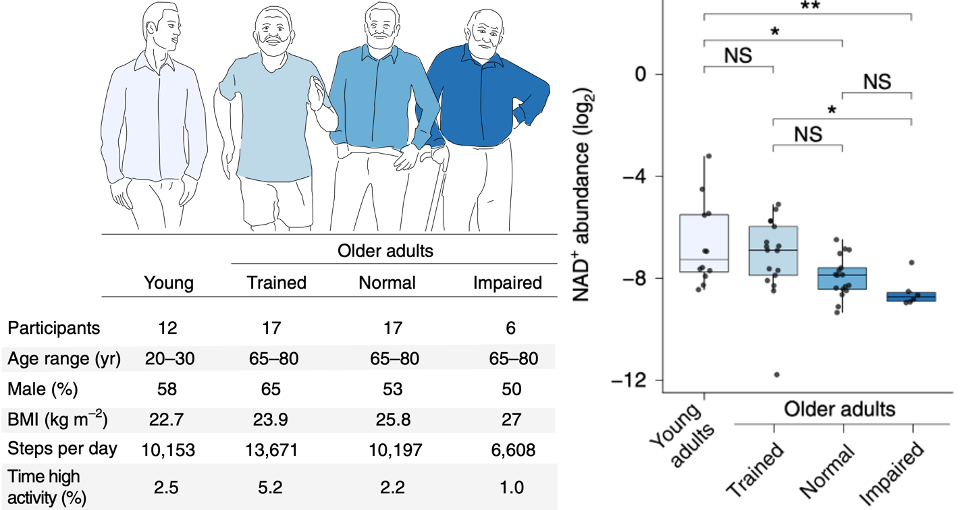Key Points
- In muscle, NAD+ is one of the most depleted metabolites associated with aging and the decline of physical ability.
- NAD+ levels are essentially the same in young adults and exercise-trained older adults.
- Boosting NAD+ is just one of the cellular processes underlying the benefits of exercise.
Exercise isn’t just for looking good – it’s for staying healthy and living longer. Physical activity and exercise are well-established countermeasures against muscle aging. Now, a study reveals that the root of exercises’ anti-aging effects on muscle is boosting NAD+ (nicotinamide adenine dinucleotide) – a molecule vital for producing the energy that muscle cells need to flex.
As reported in the journal Nature Aging, Janssens and colleagues from the University of Amsterdam and Maastricht University in the Netherlands found that NAD+ is one of the most depleted metabolites in the muscle of older adults. Routine exercise seemingly prevented the depletion of NAD+, suggesting that one of the underlying defects associated with age-related disease can be prevented.
Trained Older Adults Have Youthful NAD+ Levels
In one of the few clinical trials (NCT03666013) of its kind, Janssens and colleagues split participants into four categories. The first group consisted of healthy 20-30 year old adults who exercised a maximum of one hour per week. The data from these young adults was compared to the data from older adults between 65-80 years old. The older adults were divided into three subcategories based on their physical abilities/habits: those who exercised a minimum of 3 hours per week (trained), a maximum of 1 hour per week (normal), and a maximum of 1 hour of exercise per week and low physical performance test scores (impaired).

(Janssens et al., 2022 | Nature Aging) Exercise May Rescue NAD+ Levels in Older Adults. Trained older adults have comparable NAD+ levels to young adults. NAD+ levels are depleted in normal and impaired older adults.
From each participant, Janssens and colleagues measured the abundance of 137 different metabolites – the molecules formed, reformed, broken down, converted, synthesized, etc., as the cell works to perform its particular function. Depending on the body’s age and amount of exercise, these metabolites can change drastically.
The Dutch scientists found that one of the most depleted metabolites in untrained older adults was NAD+. Furthermore, by correlating metabolite levels to age and physical ability, Janssens and colleagues found a trend showing that the adverse metabolic changes that occur with aging could be reversed with exercise. Particularly, the trained older adults had NAD+ levels comparable to the young adults.
NAD+ Correlates with Steps Walked per Day
As part of a previous study from the same clinical trial (NCT03666013), several muscle-related parameters were measured from the three groups of older adults. These parameters included the number of steps walked per day. Janssens and colleagues cross-analyzed these parameters with their metabolite readings to find that NAD+ is associated with a higher number of steps walked per day. This suggests that NAD+ levels could be maintained in old age simply by increasing activity levels, likely through routine exercise.

(Janssens et al., 2022 | Nature Aging) NAD+ Levels Correlate with Number of Steps Walked per Day. There is a positive correlation between NAD+ levels and the number of steps walked by older adults.
Does Boosting NAD+ Underly the Benefits of Exercise?
Janssens and colleagues’ study is one of the very few to show that NAD+ declines in human tissue. Other studies have shown that NAD+ declines in human brain and skin tissue. While one study showed that NAD+ activity is reduced in older adults with age-related muscle decline, these Netherlands-based scientists are the first to show that NAD+ declines with age in healthy human muscle. Therefore, it is possible that NAD+ depletion contributes to age-related muscle decline, hindering physical ability.
Muscle is highly affected by the aging process. Age-induced loss of muscle mass and function leads to mobility impairments, increased risk of falls, and physical frailty. Muscle metabolism also declines with age, as shown by conditions like decreased insulin sensitivity. Exercise helps to protect against this age-related muscle decline, and the research from Janssens and colleagues gives us more insight into why.
Animal studies have shown that increasing NAD+ improves muscle function, including recovery, endurance, insulin sensitivity, and lifespan extension. Now, Janssens and colleagues have shown that NAD+ abundance is an indicator of muscle health in aging individuals. Since exercise increases NAD+ levels, it may be the underlying reason for mitigating age-related muscle decline. However, the authors note:
“Because of its cross-sectional design, our study does not prove that exercise can prevent the aging related decline in muscle NAD+ levels, and a follow-up prospective study is required to address this issue. Furthermore, our work does not eliminate the possibility that if the physiology of an individual is such that they possess higher NAD+ levels when they are older, then they may be predisposed to higher activity levels (reverse causation possibility). Therefore, causal involvement is difficult to conclude.”
Additionally, several studies have used NAD+ precursors to boost NAD+ but did not see improvements in muscle function. This would suggest that other factors in addition to NAD+ play a role in preventing muscle decline. Exercise may boost NAD+, but it also induces a grandiose cascade of other beneficial hormonal and cellular effects that can’t be replicated with just one molecule.